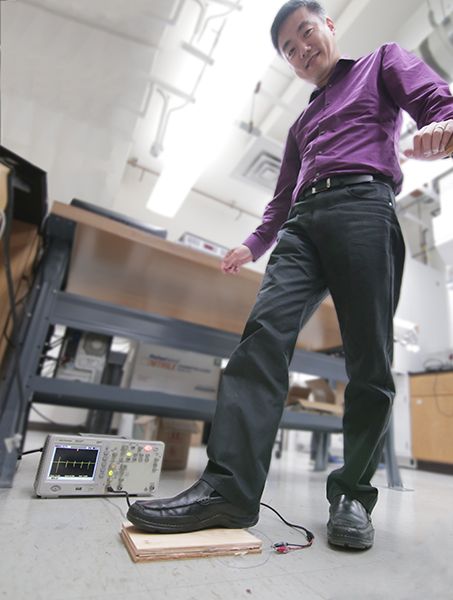Move Over Solar: There’s New Energy Right At Our Feet
Engineers at the University of Wisconsin-Madison are turning wood pulp, a common waste material, into a flooring that generates electricity
/https://tf-cmsv2-smithsonianmag-media.s3.amazonaws.com/filer/23/ec/23ecfd78-6916-4829-9c48-5643eff882a0/xudong_wang-triboelectric_flooring.jpg)
The next time you’re running through an airport to catch your plane or busting a move on the dance floor, you could also be generating clean, green energy. At least, that’s the hope of Xudong Wang and his team of researchers at the University of Wisconsin-Madison.
The engineers have invented a new type of flooring made out of sustainable materials that converts footsteps into usable energy. And the best part is that it’s made out of a common waste material: wood pulp.
With an anticipated uptick in oil prices just around the corner, finding new sources of energy—green energy—is essential. While solar seems to be sticking, with the U.S.’s solar capacity growing by 43 percent each year and other innovations like solar textiles months away from market, there’s still a need to think outside the sunny window box.
Enter Wang and his research team.
“This is a totally different energy source,” says Wang, an associate professor of materials science and engineering at UW-M. The research was conducted by Wang, his graduate student, Chunhua Yao, and several others, and was published in Nano Energy this September. “Solar comes from the sun, and this type of energy comes from people walking or bikes passing by. And it's harnessed completely different.”
It also has completely different application areas than solar because it doesn’t depend on sunny skies to work; all it needs is a few people to walk across it. Wang’s flooring generates energy through vibration, which is known as triboelectricity.
“We use a triboelectric energy harvesting board made from cellulose fibers that are chemically-treated to attract electrons,” says Wang, who acknowledges that the chemical details cannot be released until the patent review process is complete.
The researchers chemically treated the wood pulp nanofibers that the flooring is made out of with two differently charged materials, so that when someone walks across the floor, these fibers then interact with one another, similar to static electricity. The electrons released by this vibration are then captured by a capacitor that is attached to the flooring and the energy is stored for later use. Plug a battery or other device into the capacitor, and the energy can be used.

Wang believes that his flooring could be the next big thing for green building, because it’s an inexpensive renewable energy source that utilizes recyclable materials. Installing this type of flooring is much more feasible than its more expensive counterparts, such as solar panels, because of the use of sustainable—and abundant—wood pulp.
Wang says that it could be placed in areas with high levels of foot traffic like airports, sports stadiums or malls. In fact, Wang hopes that the triboelectric flooring will expand beyond commercial use and infiltrate homes as flooring that can charge lights and appliances. The final product will look similar to the wood floors already installed in millions of homes.
The idea is to eventually use this innovative design to capture “roadside energy.” Yet, Wang’s design isn’t like the current technology already used for this type of harvesting—ceramic-based piezoelectric materials—and, Wang says, “the wood pulp may be more vulnerable to the harsh conditions,” meaning it would need a better interface or packaging to work as a substitute for asphalt.
Like any type of new technology, there will be some initial limitations.
“The biggest challenge to triboelectric energy is its unconventionality,” says Eric Johnson, editor-in-chief emeritus of the journal Environmental Impact Assessment Review. “To succeed, it needs investment. Investors like familiarity, if not certainty—something they know.”
Johnson points out that many of the current mainstream technologies had similar hurdles to jump. Solar, for example, once a difficult-to-swallow concept, now literally dominates the renewable energy market.
Regardless, as the alternative energy industry continues to make major strides within the marketplace, Johnson says that the decision to move forward with many of these innovations generally depend less on the actual technology and more on economics and perceived safety.
So, Wang and his team first need to build a prototype to test the flooring on a larger scale.
“Right now, the small piece we are testing in our lab is about four square inches and can produce one milliwatt of power,” says Wang. The team performed a simple calculation for a 10-foot-by-10-foot floor area covered with their triboelectric flooring. By assuming that an average of 10 people walked on the area and each person took two steps every second, the overall energy output would be roughly 2 Joules per second. To put that another way, Wang says that amount of energy generated would equate to about 30 percent of an iPhone 6 battery.
“Because this is such a cost effective approach since it uses recycled materials,” says Wang, “we are trying to make it into large floor panels to install it in a high traffic place to really test how much power can be produced.”
They are working with the Madison-based Forest Product Laboratory, which is the only federal laboratory that is dedicated to forest products research and used primarily by the U.S. Forest Service. The lab is supplying not only the wood pulp fiber but also helping the team create a larger prototype.
Fortunately, Wang can select a high traffic area on UW-M’s campus to test it out. With over 43,000 students on campus at any given them, his prototype will certainly get a major workout.
/https://tf-cmsv2-smithsonianmag-media.s3.amazonaws.com/accounts/headshot/Kristen_A._Schmitt.jpg)
/https://tf-cmsv2-smithsonianmag-media.s3.amazonaws.com/accounts/headshot/Kristen_A._Schmitt.jpg)